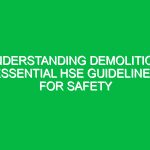Introduction
In the complex realm of Health, Safety, and Environment (HSE), the concept of a “definition scaffold” emerges as a crucial framework. But what exactly is a definition scaffold? In simple terms, it serves as a structured framework that guides organizations in defining terms, concepts, and processes pertinent to health, safety, and environmental practices. This scaffold is essential for ensuring clarity and consistency, which are necessary for successful communication, training, and compliance in HSE practices.
By establishing a solid definition scaffold, organizations can better navigate the intricate web of Regulations, standards, and Best Practices that govern the HSE domain. This article delves into the essential components of a definition scaffold within HSE, explores its significance, and offers insights into how it can enhance Safety culture and compliance in various industries.
Understanding Definition Scaffold in HSE Context
A definition scaffold is more than just a set of definitions; it is a comprehensive tool that helps organizations articulate their Safety policies, procedures, and expectations. At its core, it involves a systematic approach to defining key terms and processes that are critical to HSE management.
Key aspects of a definition scaffold in the HSE context include:
- Clarity: A well-defined scaffold ensures that everyone in the organization understands what is expected, reducing the risk of misinterpretation.
- Consistency: Consistent terminology across all documentation and Training materials helps maintain a unified approach to HSE practices.
- Compliance: A robust definition scaffold supports adherence to regulatory requirements by clearly outlining the necessary Procedures and guidelines.
- Training: It serves as a foundation for training programs, ensuring that all employees are equipped with the knowledge needed to operate safely.
The Components of a Definition Scaffold
To effectively implement a definition scaffold in HSE, organizations should consider several key components:
1. Key Terminologies
A definition scaffold begins with identifying and defining key terminologies relevant to HSE. This includes terms like “hazard,” “risk,” “incident,” and “sustainability.” Each term should be clearly defined in a way that is easily understandable by all employees, regardless of their background or role within the organization.
2. Policies and Procedures
Next, the scaffold should encompass the policies and procedures that govern HSE practices. This includes emergency response protocols, reporting procedures for incidents, and guidelines for conducting risk assessments. Providing clear definitions and descriptions of these policies helps ensure that employees know how to act in various situations.
3. Roles and Responsibilities
Defining roles and responsibilities within the HSE framework is crucial. A definition scaffold should clearly outline who is responsible for what, from management to frontline workers. This clarity promotes accountability and fosters a culture of safety.
4. Training Requirements
Training is a vital aspect of HSE success. The definition scaffold should include the training requirements for various roles, specifying what employees need to know and how they will be trained. This ensures that everyone is prepared to uphold health and safety Standards.
5. Evaluation and Feedback Mechanisms
Lastly, a robust definition scaffold includes mechanisms for evaluation and feedback. This can involve regular assessments of HSE practices and gathering input from employees about the effectiveness of current policies and procedures. Continuous improvement is key to maintaining a high standard of health and safety.
The Benefits of Implementing a Definition Scaffold
Implementing a definition scaffold in HSE offers numerous benefits:
- Enhanced Communication: Clear definitions foster better communication among employees, reducing the likelihood of misunderstandings that can lead to accidents.
- Improved Compliance: With well-defined policies and procedures, organizations are better positioned to comply with HSE regulations.
- Increased Employee Engagement: When employees understand their roles and responsibilities, they are more likely to take ownership of safety practices.
- Reduction in Incidents: Clarity and consistency in HSE practices can lead to a reduction in workplace incidents and injuries.
Real-Life Example: A Case Study in HSE Definition Scaffold
To illustrate the effectiveness of a definition scaffold, consider a hypothetical manufacturing company, XYZ Corp. Facing an increase in workplace incidents, XYZ Corp decided to reevaluate its HSE practices. They recognized the need for a robust definition scaffold.
The company began by assembling a team of HSE professionals and employees from various departments to identify key terminologies relevant to their operations. They developed a comprehensive glossary that included definitions of terms like “PPE” (personal protective equipment), “near-miss,” and “safety audit.”
Next, XYZ Corp created clear policies and procedures based on these definitions. For example, they established a standardized procedure for reporting safety incidents, which included specific definitions of what constitutes an incident. This clarity helped employees understand when and how to report issues.
Training sessions were then conducted to ensure all employees were familiar with the new definitions and procedures. The results were significant: within six months, XYZ Corp reported a 30% decrease in workplace incidents, attributed to better communication and understanding of safety practices.
Regulations and Standards Governing Definition Scaffold
Several regulations and standards influence the implementation of a definition scaffold in HSE. Here are a few key ones:
1. Occupational Safety and Health Administration (OSHA)
In the United States, osha sets forth regulations that require employers to provide a safe workplace. This includes clear communication about Hazards and safety practices, which can be enhanced through an effective definition scaffold.
2. ISO 45001
ISO 45001 is an international standard for Occupational Health and safety management systems. It emphasizes the importance of clear definitions and responsibilities, making it a valuable reference for organizations looking to establish a definition scaffold.
3. Environmental Protection Agency (EPA)
The EPA governs environmental regulations that also require clear definitions and practices to ensure compliance. Organizations must define terms related to environmental Hazards and waste management to adhere to these standards.
Actionable Insights for Developing a Definition Scaffold
For organizations looking to develop an effective definition scaffold within their HSE framework, consider the following actionable insights:
- Engage Employees: Involve employees from various levels and departments in the development process to ensure that the definitions are relevant and comprehensive.
- Regularly Review and Update: HSE practices and regulations evolve, so it is essential to regularly review and update the definition scaffold to reflect current standards and practices.
- Utilize Technology: Leverage technology to create accessible online resources where employees can easily find definitions and procedures.
- Promote a Safety Culture: Foster an organizational culture that prioritizes safety and encourages employees to continuously engage with and contribute to the definition scaffold.
Conclusion
In the intricate world of Health, Safety, and Environment, a well-structured definition scaffold is not merely a helpful tool; it is a foundational element for success. By providing clarity, consistency, and compliance, it enhances communication and fosters a culture of safety that can lead to reduced incidents and a more engaged workforce.
As organizations continue to navigate the complexities of HSE regulations and practices, embracing the concept of a definition scaffold will be essential. It serves as a guiding light, illuminating the path toward a safer and more sustainable workplace. The time to act is now; by investing in a robust definition scaffold, organizations can ensure that health, safety, and environmental considerations remain at the forefront of their operational strategies.


